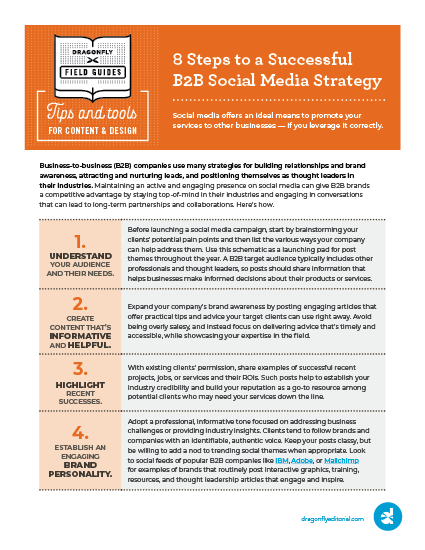Business-to-business (B2B) companies use many strategies for building relationships and brand awareness, attracting and nurturing leads, and positioning themselves as thought leaders in their industries. Maintaining an active and engaging presence on social media can give B2B brands a competitive advantage by staying top-of-mind in their industries and engaging in conversations that can lead to long-term partnerships and collaborations. Here’s how.
1. Understand your audience and their needs.
Before launching a social media campaign, start by brainstorming your clients’ potential pain points and then list the various ways your company can help address them. Use this schematic as a launching pad for post themes throughout the year. A B2B target audience typically includes other professionals and thought leaders, so posts should share information that helps businesses make informed decisions about their products or services.
2. Create content that’s informative and helpful.
Expand your company’s brand awareness by posting engaging articles that offer practical tips and advice your target clients can use right away. Avoid being overly salesy, and instead focus on delivering advice that’s timely and accessible, while showcasing your expertise in the field.
3. Highlight recent successes.
With existing clients’ permission, share examples of successful recent projects, jobs, or services and their ROIs. Such posts help to establish your industry credibility and build your reputation as a go-to resource among potential clients who may need your services down the line.
4. Establish an engaging brand personality.
Adopt a professional, informative tone focused on addressing business challenges or providing industry insights. Clients tend to follow brands and companies with an identifiable, authentic voice. Keep your posts classy, but be willing to add a nod to trending social themes when appropriate. Look to social feeds of popular B2B companies like IBM, Adobe, or Mailchimp for examples of brands that routinely post interactive graphics, training, resources, and thought leadership articles that engage and inspire.
5. Customize posts for various platforms.
Savvy media strategists understand it’s unwise — and ineffective — to simply copy and paste the same content across their accounts on LinkedIn, Facebook, X (formerly known as Twitter), Instagram, and other platforms. Each social channel has its own audiences, who in turn expect a certain type and form of content. Consider these distinctions when deciding what to post where. Share professional insights (i.e., thought leadership articles or industry trend forecasts) on LinkedIn, visually driven posts on Instagram, how-to videos on YouTube, timely updates on X, and fun, behind-the-scenes insights on Facebook, for example.
6. Engage with followers.
Don’t operate as if your posts exist in a social vacuum. Actively encourage reader comments through targeted questions or polls. Build in staff time to respond to social media feedback promptly; the investment will be worth the relationship-building it fosters with brand followers. Use the conversations that happen in the comments as a source for future post ideas, particularly if the same questions keep popping up.
B2B engagement involves discussions around industry news, expert opinions, and collaborative problem-solving. Lean into this.
7. Build a content calendar.
When possible, tailor your posts to seasonal themes or to yearly or quarterly challenges your target clients may be facing. Stay on track by creating a content calendar at the beginning of the year, so everyone on your team knows what topics have been covered — and which ones are still to come. Consider when your organization plans to publish important reports, case studies, white papers, and executive thought leadership articles — these meaty and insightful pieces of content will attract your B2B target audience. Stuck for ideas? Use online tools like Google Trends, Semrush, or Quora to discover common online search queries and trending keywords, which can serve as a springboard for post topics.
8. Monitor your results.
Effective social media strategies take trial and error. But you can’t build on what’s working, or even identify what isn’t, without strategic monitoring of your posts’ social performance. B2B metrics may include lead generation, website traffic, engagement on professional networks, and conversion rates from social media to website visits, while business-to-consumer (B2C) metrics often focus more on engagement such as likes, shares, and comments.
Use one or more of the many free social media monitoring tools or paid social media management platforms to get insights on what’s connecting with your audience and why. Use this intel to continue building out your social media presence, while remembering to maintain a brand voice that’s consistent, engaging, and on trend.
These B2B social media strategies will help you elevate your brand, captivate your audience, and pave the way for rewarding partnerships.


